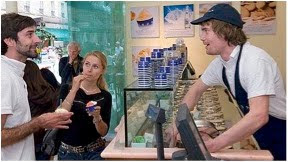According to the Australians, the chef of the Hotel Esplanade in Perth, Western Australia, Herbert Sachse, created the pavlova to celebrate the visit of the great Russian ballerina, Anna Pavlova. According to the New Zealanders, a recipe was recorded in 1919, long before the ballerina came to dance.
"A symphony of silence! So Pavlova has been described," began the report in the West Australian on Tuesday, July 9, 1929. "But who, seeing the famous ballerina for the first time as she stood on the deck... at Fremantle yesterday, could apply the description? It was Babel itself!" The reporter managed to share her cab into Perth... "They are funny, these Australians," she pronounced in the cab... The next night she gave the first of 11 evening... performances... "Exquisite Pavlova!..." began the West Australian. It was her only Perth season, on her second Australian tour. She died two years later. Yet her memory survived at her hotel, the Esplanade, because there six years later the chef whipped up the meringue and cream cake which perpetuates her name....
One person who had been researching the NZ claims had the librarians of the National Library of New Zealand consult their collection of cookery books. “In fact, they found a recipe for "Pavlova cakes" ... published in 1929. The ingredients were roughly those of a pavlova, but it was not the pavlova as we know it, because the mixture was baked into three dozen little meringues. It seems a coincidence that the NZ cook was impressed by the ballerina's lightness and whiteness.
But there is more to the NZ claim than this. Even earlier, in "Terrace Tested Recipes", collected by the ladies of Terrace Congregational Church, the second edition published in Wellington in 1927, there was a recipe submitted by a Mrs. McRae for Meringue Cake [He then describes the recipe]. From similar recipes published in 1933 and 1934, I think it is fair to say that the Meringue Cake was common in NZ in the early 1930s. Its form varied, but it was to all intents and purposes what we know as a "Pavlova", sometimes even complete with passionfruit on top.
"Bert Sachse said in a magazine interview in 1973 that he sought to improve the Meringue Cake. There was a prize-winning recipe for Meringue Cake in the "Women's Mirror" on April 2, 1935. It contained vinegar, but no cornflour and was of two parts filled with whipped cream. The recipe was contributed by "Rewa", who happened to be of Rongotai, NZ. If Sachse read the "Women's Mirror" and other magazines for ideas, as his widow told me, he might have seen this recipe. We can concede that New Zealanders discovered the secret delights of the large meringue with the "marshmallow centre", the heart of the pavlova. But it seems reasonable to assume that someone in Perth attached the name of the ballerina...
"In the "Good Food Guide" to British Isles restaurants in 1977, a glossary of food terms referred to the pavlova as a NZ offering, which changed the next year to Australian. Hilary Fawcett, who compiled the glossary, wrote to me about the change: "There does seem to be some controversy as to whether the wretched thing originated in NZ or Australia and I was reduced to doing a straw-vote count."
"It is possible, if ungenerous, to deride the pavlova for culinary innocence. It was adopted from New Zealand. Yet Herbert Sachse made a genuine, crystallising contribution. The pavlova served its original purpose admirably. It then caught the popular imagination. Distilling the Australian concept of sweet living, it is the single great discovery thus far of our cooking."
Extract taken from http://www.inmamaskitchen.com/FOOD_IS_ART/reference/Pavlova.html
Whether you are from Australia, New Zealand or elsewhere, this is truly a delightful dessert to eat at any time of year.
Pavlova
Serves 6
Preparation and cooking times
Prep 30 mins
Cook 1 hr 30 mins
Plus time to cool
Ingredients
• 4 egg whites
• 225g caster sugar
• 1 tsp cornflour
• 1 tsp white wine vinegar
• ½ vanilla pod
• 284ml carton double cream
• 1 lemon , zested
• 450g berries , raspberries, strawberries, or
blackberries or a mixture
• 1 tbsp icing sugar
Method
1. Heat the oven to 180C/fan 160C/gas 4. Cover a baking sheet with baking parchment. Whisk the egg whites with electric beaters until they just form stiff and shiny peaks. Gradually add the sugar a couple of tablespoons at a time and whisk really well between each addition. When all of the sugar is used up continue whisking for 3-4 minutes or until the meringue is stiff and glossy and stands up in peaks, then whisk in the cornflour and vinegar. Spoon the mixture onto the baking parchment and use a palette knife to make a circle about 20cm in diameter. Put in the oven, turn the temperature down to 120C/fan 100C/gas ½ and cook for 1½ hours. Turn the oven off and leave the meringue inside until completely cold (you can make this the day before and leave to cool overnight).
2. Carefully peel off the baking parchment and put the pavlova on a serving dish. Don't worry if it cracks. Scrape the vanilla seeds into a mixing bowl, add the cream and lemon zest and softly whip, then spoon onto the pavlova. Mix the berries, spoon the fruit on top of the cream, dust with a little icing sugar and serve.
Tips:
* Make the pavlova the day before and then whip the cream and prepare the fruit at the last minute.
* You can use whatever fruits you want…get creative!














